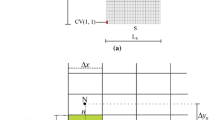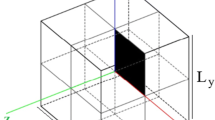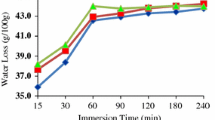Abstract
In this study, unsteady one-dimensional mass transfer during osmotic dehydration of apple was modeled using an approximate mathematical model. The mathematical model has been developed based on a power law profile approximation for moisture and solute concentrations in the spatial direction. The proposed model was validated by the experimental water loss and solute gain data, obtained from osmotic dehydration of infinite slab and cylindrical shape samples of apple in sucrose solutions (30, 40 and 50 % w/w), at different temperatures (30, 40 and 50 °C). The proposed model’s predictions were also compared with the exact analytical and also a parabolic approximation model’s predictions. The values of mean relative errors respect to the experimental data were estimated between 4.5 and 8.1 %, 6.5 and 10.2 %, and 15.0 and 19.1 %, for exact analytical, power law and parabolic approximation methods, respectively. Although the parabolic approximation leads to simpler relations, the power law approximation method results in higher accuracy of average concentrations over the whole domain of dehydration time. Considering both simplicity and precision of the mathematical models, the power law model for short dehydration times and the simplified exact analytical model for long dehydration times could be used for explanation of the variations of the average water loss and solute gain in the whole domain of dimensionless times.











Similar content being viewed by others
Abbreviations
- C:
-
Concentration (g/100 g of fresh fruit)
- De :
-
Effective diffusivity (m2/s)
- Des :
-
Effective sucrose diffusivity (m2/s)
- Dew :
-
Effective moisture diffusivity (m2/s)
- Jn :
-
Bessel function of the first kind
- l:
-
Half height of apple samples (mm)
- L:
-
Slab thickness (mm)
- P. A.:
-
Polynomial approximation method
- r:
-
Radius (mm)
- R:
-
Cylinder radius (mm)
- S:
-
Weight of solids in the fruit (g)
- S1 :
-
A constant related with water loss (h−1)
- S2 :
-
A constant related with solid gain (h−1)
- SG:
-
Solid gain (g/100 g fresh fruit)
- t:
-
Time (s)
- T:
-
Temperature (°C)
- W:
-
Weight of fruit (g)
- WL:
-
Water loss (g/100 g fresh fruit)
- X:
-
Dimensionless coordinate
- 0:
-
Initial
- e:
-
Equilibrium
- Exp:
-
Experimental
- s:
-
Sucrose
- t:
-
At the time t
- w:
-
Water
- φ:
-
Dimensionless concentration
- µn :
-
Roots of the Bessel function of the first kind
- τ:
-
Dimensionless time (=Det/R2)
- ∞:
-
At time ∞ (equilibrium)
References
Rice RG, Do DD (1994) Applied mathematics and modeling for chemical engineers, 3rd edn. Wiley, New York, pp 546–562
Holman JP (1981) Heat transfer, 9th edn. McGraw-Hill, New York, pp 133–135
Cheroto S, Silva Guigon SM, Ribeiro JW, Cotta RM (1997) Lumped-differential formulations for drying in capillary porous media. Dry Technol 15(3–4):811–835
Correa EJ, Cotta RM (1998) Enhanced lumped-differential formulations of diffusion problems. Appl Math Model 22:137–152
Regis CR, Cotta RM, Su J (2000) Improved lumped analysis of transient heat conduction in a nuclear fuel rod. Int J Commun Heat Mass Transf 27:357–366
Reis MCL, Macedo EN (2000) Improved lumped-differential formulations in hyperbolic heat conduction. Int J Commun Heat Mass Transf 27(7):965–974
Alhama F, Campo A (2001) The connection between the distributed and lumped models for asymmetric cooling of long slabs by heat convection. Int J Commun Heat Mass Transf 28(1):127–137
Su J (2001) Improved lumped models for asymmetric cooling of a long slab by heat convection. Int J Commun Heat Mass Transf 28:973–983
Su J (2004) Improved lumped models for transient radiative cooling of a spherical body. Int J Commun Heat Mass Transf 31:85–94
Keshavarz P, Taheri M (2006) An improved lumped analysis for transient heat conduction by using the polynomial approximation method. Int J Heat Mass Transf 43(11):1151–1156
Dantas LB, Orlande HRB, Cotta RM (2007) Improved lumped-differential formulations and hybrid solution methods for drying in porous media. Int J Therm Sci 46:878–889
Aoki Y, Sen M, Paolucci S (2008) Approximation of transient temperatures in complex geometries using fractional derivatives. Int J Heat Mass Transf 44:771–777
Su G, Tan Z, Su J (2009) Improved lumped models for transient heat conduction in a slab with temperature-dependent thermal conductivity. Appl Math Model 33:274–283
Tan Z, Su G, Su J (2009) Improved lumped models for combined convective and radiative cooling of a wall. Appl Therm Eng 29:2439–2443
Brennan JG (1994) Food dehydration: a dictionary and guide, 2nd edn. Butterworth-Heinemann Series in Food Control, Oxford
Lenart A (1996) Osmotic-convective drying of fruits and vegetables: technology and application. Dry Technol 18(4–5):951–966
Panagiotou NM, Karanthanos VT, Maroulis ZB (1999) Effect of osmotic agent on osmotic dehydration of fruits. Dry Technol 17(1–2):175–189
Rastogi NK, Raghavarao KSMS, Niranjan K, Knorr D (2002) Recent developments in osmotic dehydration: methods to enhance mass transfer. Trends Food Sci Technol 13:48–59
Floury J, Le Bail A, Pham QT (2008) A three-dimensional numerical simulation of the osmotic dehydration of mango and effect of freezing on the mass transfer rates. J Food Eng 85:1–11
Abbasi Souraki B, Ghaffari A, Bayat Y (2012) Mathematical modeling of moisture and solute diffusion in the cylindrical green bean during osmotic dehydration in salt solution. Food Bioprod Process 90:64–71
Amami E, Vorobiev E, Kechaou N (2006) Modelling of mass transfer during osmotic dehydration of apple tissue pre-treated by pulsed electric field. LWT Food Sci Technol 39:1014–1021
Azuara E, Flores E, Beristain CI (2009) Water diffusion and concentration profiles during osmodehydration and storage of apple tissue. Food Bioprocess Technol 2(4):243–250
Derossi A, De Pilli T, Severini C, McCarthy MJ (2008) Mass transfer during osmotic dehydration of apples. Food Eng 86:519–528
Kaymak-Ertekin F, Sultanoglu M (2000) Modelling of mass transfer during osmotic dehydration of apples. J Food Eng 46:243–250
Li Heping, Ramaswamy HS (2006) Osmotic dehydration of apple cylinders: I. Conventional batch processing conditions. Dry Technol 24:619–630
Ochoa-Martinez CI, Ramaswamy HS, Ayala-Aponte AA (2007) A comparison of some mathematical models used for prediction of mass transfer kinetics in osmotic dehydration of fruits. Dry Technol 25:1613–1620
Abbasi Souraki B, Tondro H, Ghavami M (2013) Modeling of mass transfer during osmotic dehydration of apple using an enhanced lumped model. Dry Technol 31:595–604
Do DD, Mayfield PLJ (1987) A new simplified model for adsorption in a single particle. J AIChE 33:1397–1400
Waliszewski KN, Texon NI, Salgado MA, García MA (1997) Mass transfer in banana chips during osmotic dehydration. Dry Technol 15:2597–2607
Crank J (1975) The mathematics of diffusion, 2nd edn. Oxford University Press, New York
Author information
Authors and Affiliations
Corresponding author
Rights and permissions
About this article
Cite this article
Abbasi Souraki, B., Tondro, H. & Ghavami, M. Simulation of mass transfer during osmotic dehydration of apple: a power law approximation method. Heat Mass Transfer 50, 1443–1453 (2014). https://doi.org/10.1007/s00231-014-1351-z
Received:
Accepted:
Published:
Issue Date:
DOI: https://doi.org/10.1007/s00231-014-1351-z




